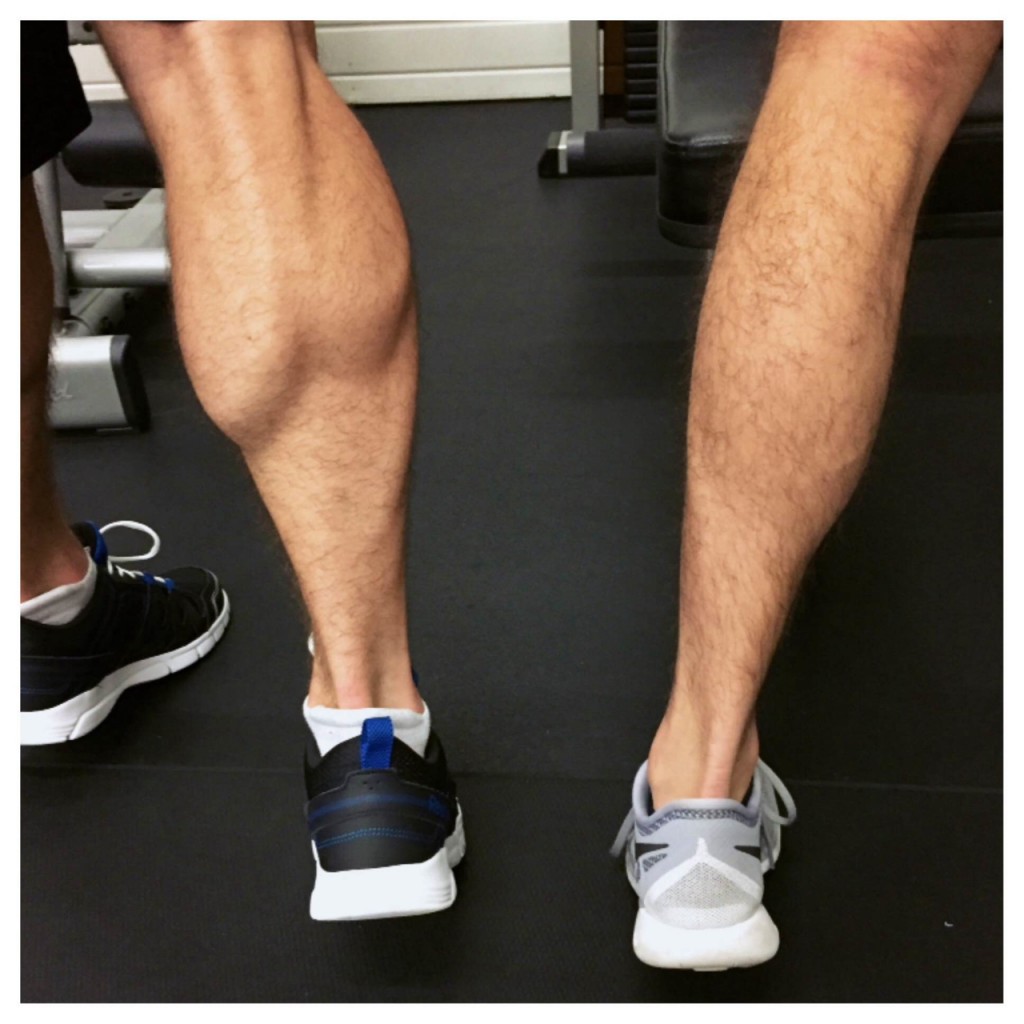In my last blog I gave an overview of how genetics can affect fat loss. In this blog we will look at the other side of the coin — muscle growth!
Genetics influence nearly all muscular properties and contribute significantly to muscle size and composition. Muscle fiber numbers are believed to be determined around the second trimester of fetal development. Even when you add in training, genetically programmed responses determine HOW MUCH growth you can achieve. Take a look at the photo above. Both of these individuals train their calves three days per week with very similar intensity and volume, but look at the difference in results! There’s obviously more to it than just training.
The main factor is a complex mechanism called “satellite cell-mediated myonuclear addition”. Yikes, that sounds really complicated. Let me explain. Around your muscle fibers, you have these things called satellite cells. Satellite cells are special “reserve cells” that can be called upon to repair and form new muscle tissue in response to exercise. This response adds nuclei to the muscle. Nuclei act as the control centers governing muscle growth; therefore, more nuclei equals more potential for muscle growth.
For a real-world example, imagine two construction sites building skyscrapers. The skyscrapers represent muscle. Cranes represent satellite cells. Workers represent stimulus for growth (training). Building materials represent nutrition for growth. Site 1 represents someone genetically inclined to gain lean mass, while site 2 represents someone genetically inclined not to gain lean mass.
As you can see, two people can work equally as hard, eat equally as well and get vastly different results due to different amounts of these specialized satellite cells.
These differences in adaption to resistance training have been proven in research studies. Bamman and colleagues placed 66 subjects on identical programs and measured individual muscle fiber size pre- and post-measurement. The top 25% of subjects increased their muscle size by 58%, the middle 50% gained an average of 28%, and the bottom 25% did not see any change in muscle size.
Take Home
While many hardcore weight lifters and body builders would like to believe it is their hard work and dedication that separate them from smaller or less defined lifters, this is simply not always true. We all have a genetic window to work within for fat loss and muscle growth. Two people can put in an equal amount of work and dedication and come out with significantly different results. For this reason, using another person as a goal can be a slippery slope. While admiring their work ethic, training program, or adherence to a healthy lifestyle is GREAT, becoming fixated on an exact “look” or “physique” can set you up for disappointment. Working hard to improve your current health/physique and maximizing YOUR genetic potential should always be your main goal.
About the Author:
-

Michael Stack is the founder & CEO of Applied Fitness Solutions and Frontline Fitness Pros. He is a faculty lecturer for the University of Michigan’s School of Kinesiology. He is also the creator and the host of the Wellness Paradox Podcast, produced in conjunction with University of Michigan.
Michael is an exercise physiologist by training and a health entrepreneur, health educator, and fitness industry advocate by trade. He is dedicated to enhancing the standard of practice of, and advocating for, fitness and wellness professionals to ensure they become an essential constituent in the healthcare delivery system.
With a career spanning over three decades in fitness, health, and wellness Michael has a deep knowledge of exercise physiology, health/wellness coaching, lifestyle interventions to mitigate chronic disease and leadership. He is credentialed through the American College of Sports Medicine (ACSM) as an Exercise Physiologist (ACSM-EP), Exercise is Medicine practitioner (ASCM-EIM), and a Physical Activity in Public Health Specialist (ACSM-PAPHS). Michael is a National Strength & Conditioning Association (NSCA) Certified Strength & Conditioning Specialist (CSCS), and a CDC Diabetes Prevention Program (DPP) Lifestyle Coach.
Michael received his undergraduate degree from the University of Michigan’s School of Kinesiology in 2004 and is currently a Master’s of Public Health (MPH) candidate at University of Michigan, with a specific concentration in health behavior and health education.
Michael is a board of directors’ member for the Physical Activity Alliance and Michigan Fitness Clubs Association. He sits on the University of Michigan’s School of Kinesiology Alumni Board of Governors. Michael is an expert curriculum reviewer for the American College of Lifestyle Medicine. Finally, he is a member of the executive leadership team for American Heart Association’s Heart Walk.
Michael lectures nationally for several health/fitness certification and continuing educations, including; IHRSA, the Medical Fitness Association, the National Strength & Conditioning Association, and SCW Fitness.

